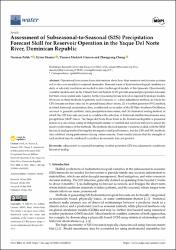Mostrar el registro sencillo del ítem
Assessment of subseasonal-to-seasonal (S2S) precipitation forecast skill for reservoir operation in the Yaque del Norte river, Dominican Republic
| Licencia | This is an open access article distributed under the terms and conditions of the Creative Commons Attribution (CC BY) license. | es |
| Autor | Pelak, Norman | |
| Autor | Shamir, Eylon | |
| Autor | Modrick Hansen, Theresa | |
| Autor | Cheng, Zhengyang | |
| Fecha de admisión | 2024-09-28T15:25:24Z | |
| Fecha disponible | 2024-09-28T15:25:24Z | |
| Año | 2024 | |
| Citación | Pelak, N., Shamir, E., Hansen, T. M., & Cheng, Z. (2024). Assessment of subseasonal-to-seasonal (S2S) precipitation forecast skill for reservoir operation in the Yaque del Norte river, Dominican Republic. Water, 16(14), 2032. Recuperado de: | es |
| URI | https://bvearmb.do/handle/123456789/5185 | |
| Sinopsis | Operational forecasters desire information about how their reservoir and riverine systems will evolve over monthly to seasonal timescales. Seasonal traces of hydrometeorological variables at a daily or sub-daily resolution are needed to drive hydrological models at this timescale. Operationally available models such as the Climate Forecast System (CFS) provide seasonal precipitation forecasts, but their coarse spatial scale requires further processing for use in local or regional hydrologic models. We focus on three methods to generate such forecasts: (1) a bias-adjustment method, in which the CFS forecasts are bias-corrected by ground-based observations; (2) a weather generator (WG) method, in which historical precipitation data, conditioned on an index of the El Niño–Southern Oscillation, are used to generate synthetic daily precipitation time series; and (3) a historical analog method, in which the CFS forecasts are used to condition the selection of historical satellite-based mean areal precipitation (MAP) traces. The Yaque del Norte river basin in the Dominican Republic is presented herein as a case study, using an independent dataset of rainfall and reservoir inflows to assess the relative performance of the methods. The methods showed seasonal variations in skill, with the MAP historical analog method having the strongest overall performance, but the CFS and WG methods also exhibited strong performance during certain seasons. These results indicate that the strengths of each method may be combined to produce an ensemble forecast product. | es |
| Idioma | English | es |
| Publicado | Water, 16(14), 2032 | es |
| Derechos | © 2024 by the authors. Licensee MDPI, Basel, Switzerland. | es |
| URI de derechos | https://creativecommons.org/licenses/by/4.0/ | es |
| Materia | Recursos naturales - República Dominicana | es |
| Materia | Recursos hídricos | es |
| Materia | Clima - República Dominicana | es |
| Título | Assessment of subseasonal-to-seasonal (S2S) precipitation forecast skill for reservoir operation in the Yaque del Norte river, Dominican Republic | es |
| dc.identifier.doi | https://doi.org/10.3390/w16142032 | |
| Tipo de material | Article | es |
| Tipo de contenido | Scientific research | es |
| Acceso | Open | es |
| Audiencia | Technicians, professionals and scientists | es |
Ficheros en el ítem
Este ítem aparece en la(s) siguiente(s) colección(es)
-
Investigación ambiental [1725]


